Fred Martin
From the Chinese paintings, Taoism, June 2000.
Click here for
February-May, 2000
Click here for the China
Notebooks, June 2000
Click here for July-December 2000
Click here for
directory to all paintings
Unless otherwise noted,
all paintings are Chinese ink and watercolor on paper, sizes vary.
Beginning in summer 1986, most years I led a
student group on a trip to China. I had decided that the year 2000 trip
would probably be my last (and it has been), and that the students needed more
of an introduction to traditional Chinese culture that they had been getting.
What follows below is material from the talks I gave on the roof of our studio
in Hangzhou, and--the images and text for the Tao Teh Qing--for a lecture I
gave in our Chinese painting studio
itself.
Scroll down for the paintings, click the image
for a larger view.
| |
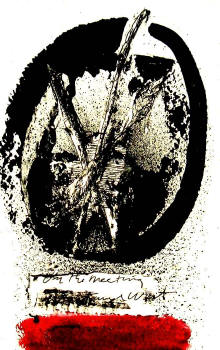
|
The
Meeting of East and West...
The Chinese Master showed the brush, the ink and paper. He said, "To
paint the landscape is to write your thoughts," and used guo,
chun and cha, followed by wash and dots. He made lines
thin and thick, used a bush wet and dry with ink light and dark. He
said, "I have in these ways for a thousand years shown the clouds
beyond the terrace and written my thoughts of Tao."
The
Western Master showed the brush and knife, the paint and canvas. He
said, "To paint the body is to make your flesh," and used lines and
lights and darks, used color and mass. He said, "These tools and
paint are forever my flesh and blood. They show my life under heaven,
crying for God. Passion is my purpose, transfiguration is my goal."
Lao Tze
said, "Regard the world in passion, there is yes and no; regard the
world in Tao, there is peace. The sage knows each in its place; that
is the Way and its Power."
|
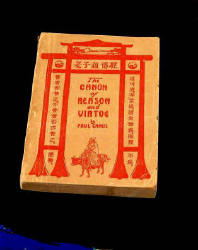
A personal
translation of the Tao Teh King,
adapted from memory of my 1949 adaptation of Paul Carus' 1910
transliteration of The Tao Teh King as The Canon of Reason and Virtue
so that it could be presented to American art students in China as a
lecture on Taoism and Buddhism as I have experienced them.
*****
|
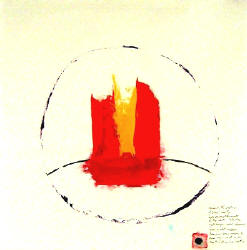
The Tao Paintings, Hangzhou, China,
June 2000.
The Gateway to the West.
Introduction
Foreseeing the decline of Zhou, Lao Tze (the Keeper of the
Secret Archives of Zhou) approached the gate to the West. "Sire,"
the Gatekeeper said, "Knowing of your great wisdom, leave us some
words to live by." And so the Tao Teh Qing was written.
|
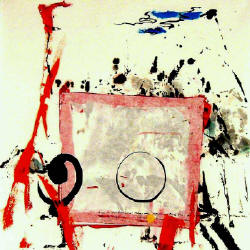
The Tao Paintings, Hangzhou, China,
June 2000.1. On the Name of the
Nameless
Before the 10,000 things were,
Heaven and Earth were;
Before Heaven and Earth were,
The Origin was;
Before the Origin was...
I do not know its name
and call it Tao. |
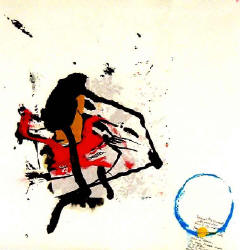
The Tao Paintings, Hangzhou, China,
June 2000.2. On Yes and No...
Regard the world in passion,
There is Yes and No.
Regard the world in Tao,
There is Peace.
The sage knows each in its place.
That is the Way and its Power.
|
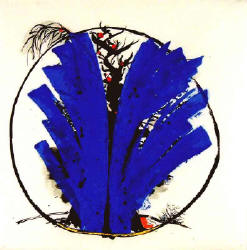
The Tao Paintings, Hangzhou, China,
June 2000.3.
The Spirit of the Valley...
The spirit of the valley is undying.
Live without fear,
It will always provide.
That is the Way and its Power. |
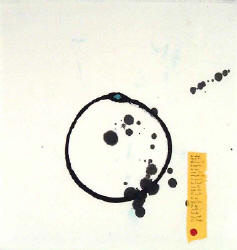
The Tao Paintings, Hangzhou, China,
June 2000. 4.
The empty vessel..
The vessel needs the emptiness at its center;
The wall needs the window for its opening;
The wheel needs the hole for its axle.
For each thing, an emptiness at the center.
That is the Way and its Power.
(Private collection, NYC) |
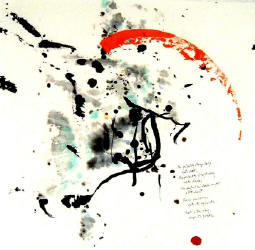
The Tao Paintings, Hangzhou, China,
June 2000. 5.
The perfectly sharp knife...
The perfectly sharp knife gets dull;
The perfectly bright day gets dark;
The perfectly dark night gets light.
Every perfection gets its opposite.
That is the Way and its Power. |
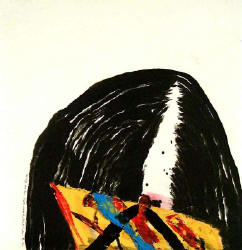
The Tao Paintings, Hangzhou, China,
June 2000.6. On High and Low...
Be high, be low.
Water seeks the lowest place. Be low.
That is the Way and its Power. |
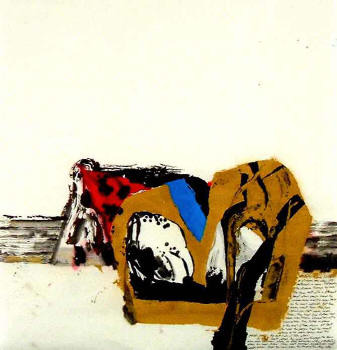
The Tao Paintings, Hangzhou, China,
June 2000 7.
Let there be a village...
Let there be a village
Where they hear the cocks crow
and the dogs bark
in the village nearby
but will never go there.
Let there be a village
where they have carriages but do not use them,
have fine clothes but do not wear them.
Generation after generation
they have peace to the end of their days.
That is the Way and its Power.
|
| |
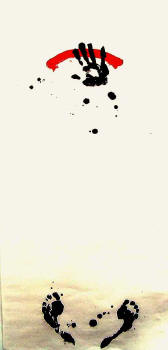
The Tao Paintings, Hangzhou, China,
June 2000.8. My departure
into the West
|
|
| |
Click here for the China
Notebooks, June 2000
Click here for July-December 2000
Click here for directory to all
paintings
|
|
|
|